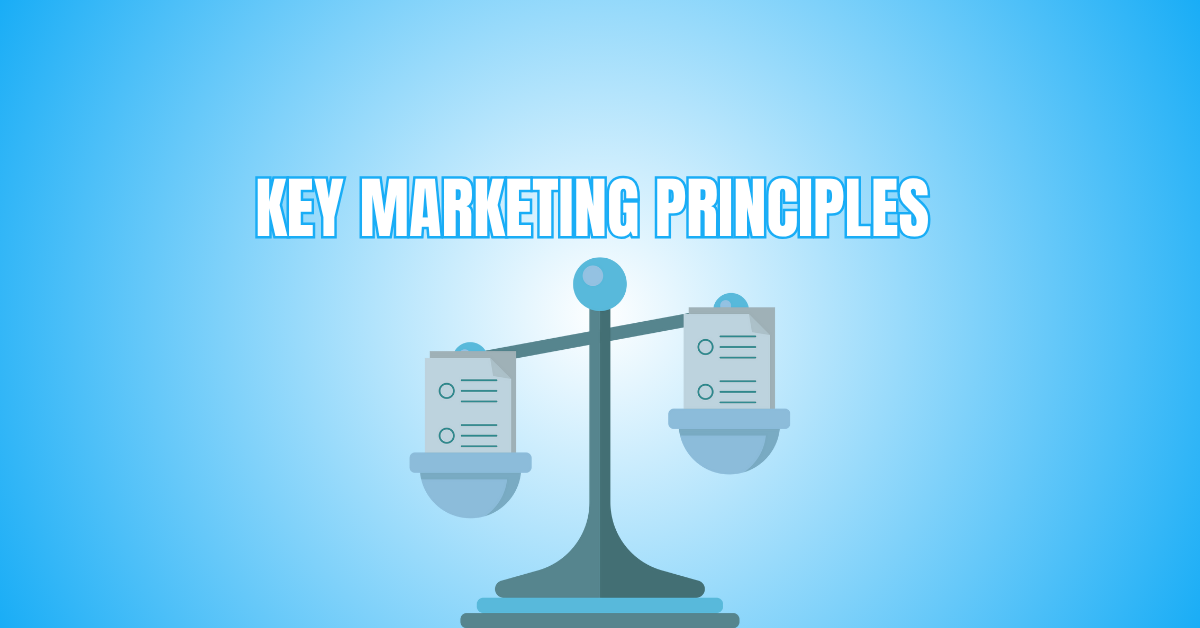Key Marketing Principles For Business Growth
Mastering key marketing principles is crucial for building strong customer relationships and driving business growth.
They help you understand your audience, craft effective messages, and create lasting value. You may improve your client interactions and make a name for yourself in a crowded market with the correct strategy.
In today's dynamic business environment, this blog will walk you through key tactics that guarantee your brand remains competitive and current.
What Are The Key Marketing Principles?
1. Know Your Audience
Every practical marketing approach begins with an understanding of your target demographic. You can’t sell effectively without knowing who you’re selling to.
Start by creating detailed customer personas — include demographics, interests, pain points, and buying behaviours. For example, Nike markets to athletes and fitness enthusiasts by addressing performance, motivation, and lifestyle.
Conduct surveys, analyze social media insights, and review customer feedback to sharpen your understanding. When you know your audience inside out, your messaging becomes more effective, and your products genuinely meet their needs.
Remember, marketing is about solving problems — knowing your customer lets you offer real solutions that matter.
2. Craft A Unique Value Proposition (UVP)
The reason you are the most excellent choice for clients is explained by your Unique Value Proposition (UVP). It’s the clear statement that highlights your most significant benefit.
For instance, Slack positions itself as “Where work happens,” promising seamless team collaboration. A strong UVP focuses on solving a customer’s problem in a way your competitors don’t.
The process? Identify your strengths, analyze customer needs, and align both in a message that’s simple and memorable.
Test different versions and gather feedback. Your UVP should appear in your website copy, ads, and pitches. A compelling UVP attracts attention, builds trust, and converts curious visitors into loyal customers.
3. Master The Four Ps Of Marketing
Mastering the Four Ps—Product, Price, Place, and Promotion—is one of the key marketing principles that ensures strategic consistency and business success.
Consider Apple’s iPhone: the product offers innovation, is priced as a premium device, is sold in exclusive outlets, and is promoted with sleek ads.
Your product should meet a need, your price must reflect value, your place of sale should align with your market, and your promotions must reach the right audience.
Review each “P” regularly to adapt to market shifts. The Four Ps aren’t just theory; they’re a practical checklist for every marketing decision you make, ensuring consistency and maximizing your business impact.
4. Use Data-Driven Marketing
In today’s competitive market, relying on gut feeling isn’t enough — data must guide your decisions. Data-driven marketing involves analyzing customer behaviour, market trends, and campaign performance to make informed choices.
Companies like Netflix use data analytics to recommend content and develop hit shows based on viewer preferences. Start by establishing specific KPIs, monitor your marketing activities using programs like Google Analytics, and modify your plan of action in light of new information.
This approach helps you reduce risks, optimize budgets, and improve ROI. With data in hand, you can spot opportunities, address weaknesses, and confidently steer your marketing toward success with measurable results.
5. Build Strong Customer Relationships
Marketing isn’t just about attracting new customers — it’s about keeping them. Strong customer relationships drive loyalty, repeat business, and referrals.
Companies like Amazon excel by using customer data to personalize experiences, making every interaction feel relevant. Implement CRM systems like HubSpot or Salesforce to track customer interactions and tailor communications.
Respond to feedback promptly and offer solutions that add value. Building relationships is an ongoing process — engage with customers regularly, not just during a sale.
Remember, happy customers become your best marketers. Focus on relationship-building, and you’ll create a loyal customer base that supports your business growth long-term.
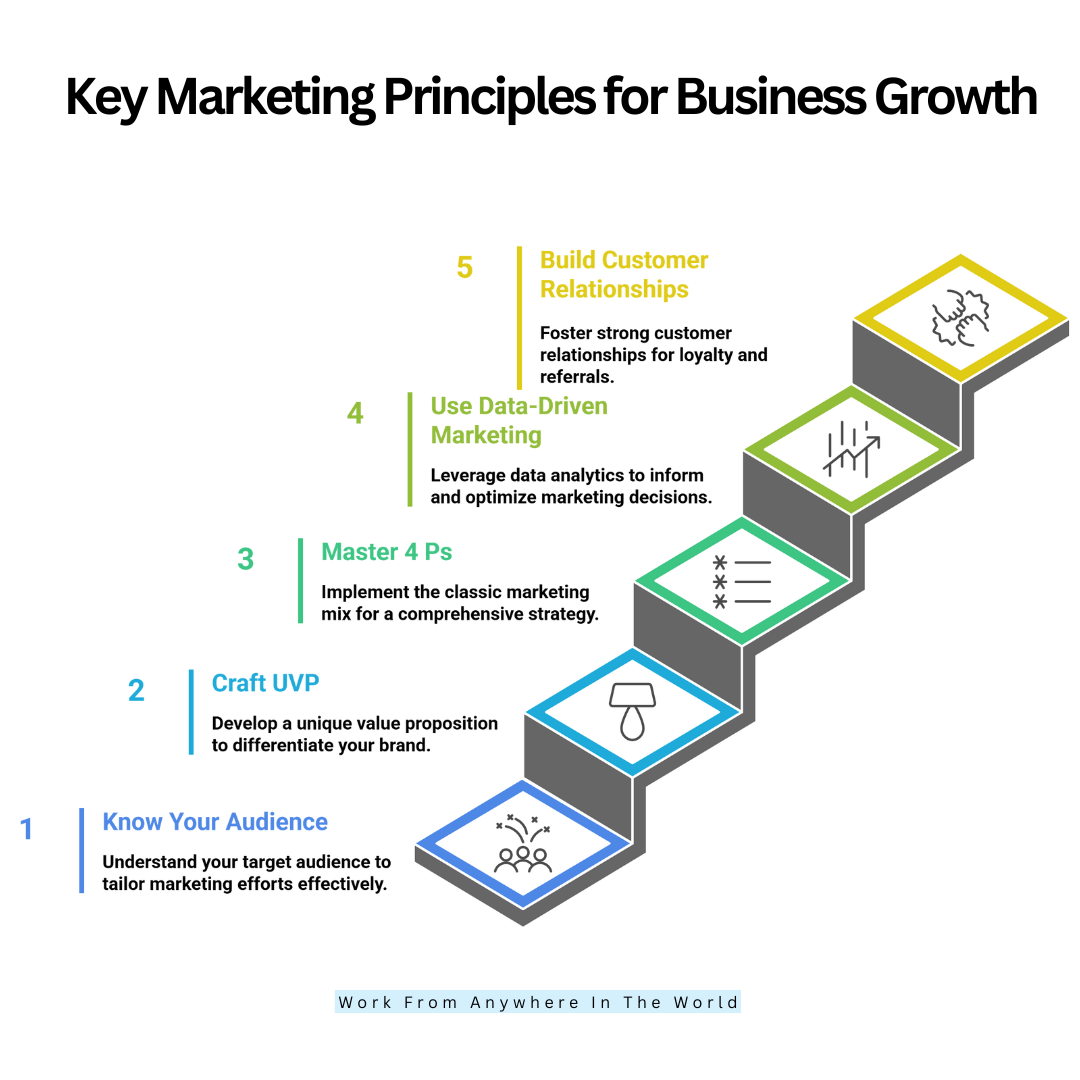
6. Be Consistent Across All Channels
Building a known and reliable brand requires consistency. Whether it’s your website, social media, ads, or packaging — everything should reflect the same voice, visuals, and message.
Think of McDonald’s: their golden arches, colour scheme, and friendly tone are instantly recognizable worldwide. Develop a brand style guide outlining colours, fonts, voice, and messaging rules.
Apply it consistently across all platforms. Conduct regular audits to ensure alignment. Consistency builds customer trust and reinforces your brand identity, making you memorable.
Inconsistent branding confuses audiences and dilutes your impact. Stay consistent, and your brand will become a familiar, reliable presence in the market.
7. Create Valuable Content
A core of key marketing principles is to create valuable, audience-focused content that builds trust and nurtures lasting customer relationships.
Jay Baer once said, “Content is fire; social media is gasoline.” Take HubSpot, for example; they offer free guides and blogs that attract leads without aggressive selling.
Determine the needs of your audience first, and then produce content that addresses their queries or resolves their issues. Optimize your content for SEO, distribute it on the right platforms, and engage with your audience.
Valuable content turns casual visitors into loyal followers. Remember, content isn’t just king — it’s the bridge to your audience’s trust.
8. Stay Agile With Market Trends
The market is constantly evolving — businesses that adapt survive and thrive. Blockbuster’s fall and Netflix’s rise show the power of adapting to change.
Stay updated on industry news, competitor moves, and consumer behaviour shifts. Use tools like Google Trends or social media listening platforms to spot changes early.
Adaptation means adjusting your products, messaging, or platforms to meet current demands. Be proactive, not reactive. Try out fresh concepts, hear what customers have to say, and improve your strategy.
Marketing agility allows you to seize opportunities and avoid pitfalls. In a world of constant change, your flexibility becomes your most substantial competitive advantage.
9. Practice Ethical Marketing
Ethical marketing isn’t just good practice — it’s a trust-building essential. Patagonia is a prime example, promoting transparency and environmental responsibility while maintaining strong customer loyalty.
Avoid misleading ads, respect customer data, and communicate honestly. Follow regulations like GDPR and prioritize your customers' best interests. Ethical marketing strengthens your reputation and builds long-term relationships.
The process involves setting ethical guidelines, training your team, and reviewing campaigns for fairness and honesty. Remember, customers support brands they trust.
As Seth Godin said, “People do not buy goods and services. They buy relations, stories, and magic.” Let your marketing reflect integrity and authenticity.
10. Always Measure Your ROI
Marketing success isn’t just about creativity — it’s about results. Measuring ROI is one of the key marketing principles that ensures your strategies are data-driven, cost-effective, and aligned with business growth.
“What gets measured, gets managed,” according to Peter Drucker. Determine return on investment (ROI) by weighing the expenses of your campaigns against the income they bring in.
Track important performance indicators with tools including ad platform insights, CRM software, and Google Analytics. Monitor metrics like lead generation, conversions, and engagement.
This helps you refine your strategies, cut waste, and maximize effectiveness. Consistent ROI tracking turns marketing from a guessing game into a data-backed growth engine that drives tangible business success.
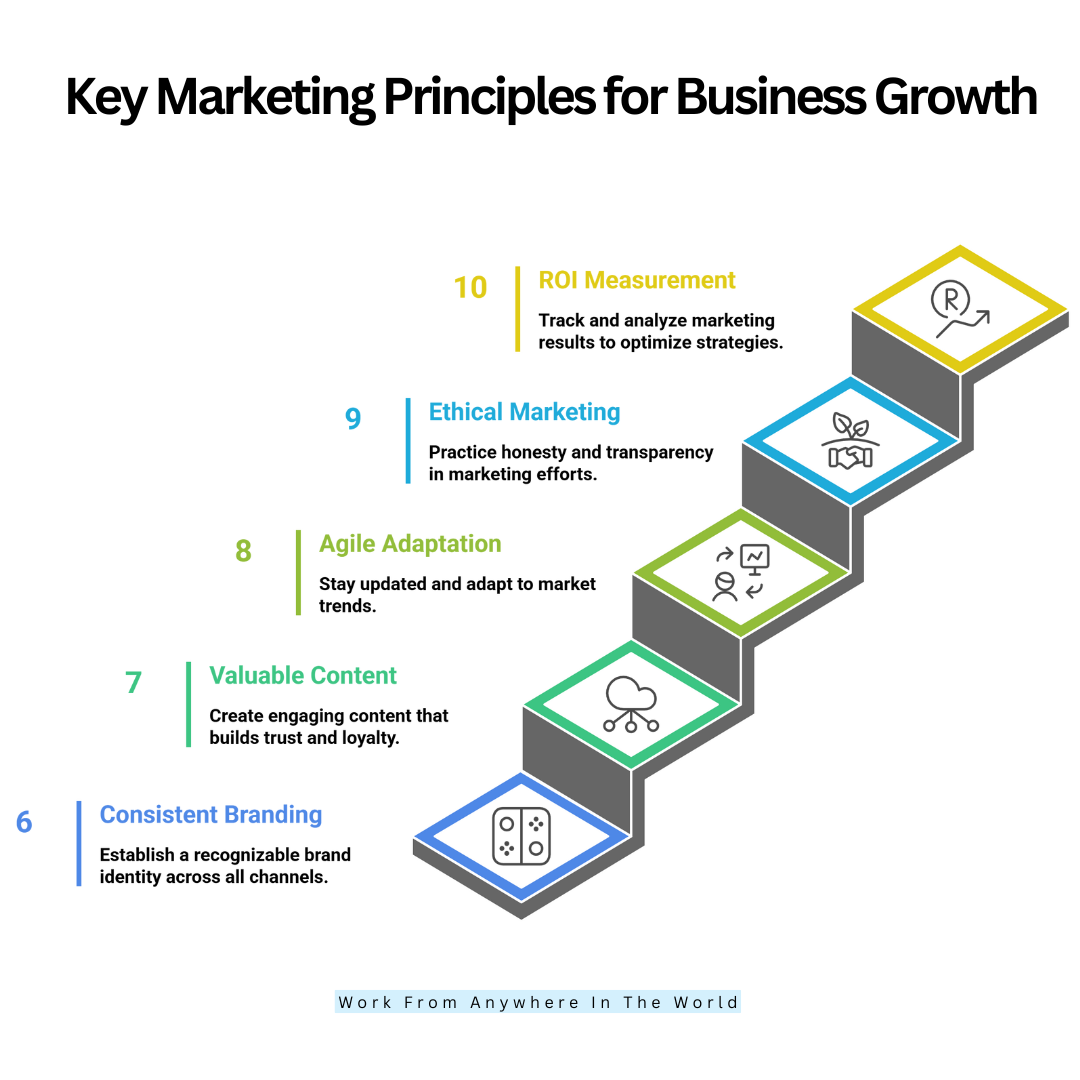
11. Embrace Multi-Channel Marketing
Multi-channel marketing means reaching customers across various platforms — social media, email, websites, and even offline.
Customers who communicate across several channels spend 10% more online and 4% more in-store, according to Harvard Business Review research.
For instance, a consumer might find a product on Instagram, look it up on your website, and then buy it through an email offer.
Use tools like marketing automation platforms to manage campaigns seamlessly across channels. The key is delivering a consistent message and experience everywhere.
Don’t rely on a single channel; broaden your reach to meet customers where they are, increasing engagement, brand visibility, and ultimately, conversions.
12. Focus On Customer Experience (CX)
Prioritizing customer experience is one of the key marketing principles that drives loyalty, enhances brand perception, and fuels sustainable business growth.
As Jeff Bezos said, “We’re not competitor obsessed; we’re customer-obsessed.” Every touchpoint — website, social media, support — shapes how customers perceive your brand.
For example, Zappos built its reputation on exceptional customer service, leading to strong loyalty. Enhance CX by streamlining navigation, offering responsive support, and personalizing interactions.
Regularly gather feedback to identify improvement areas. Positive experiences increase satisfaction, drive word-of-mouth referrals, and foster repeat business.
The customer experience isn’t just a service function — it’s a powerful marketing tool that strengthens your brand and builds long-lasting relationships with your audience.
13. Harness The Power Of Social Proof
Social proof influences buying decisions more than most realize. As Robert Cialdini said in Influence, “People will look to the actions of others to determine their own.”
Think reviews, testimonials, ratings, and user-generated content. For instance, Amazon’s product reviews significantly impact purchasing decisions.
Showcase social proof on your website, ads, and social media. Encourage satisfied customers to share feedback and reviews. The process involves collecting testimonials, displaying reviews, and promoting customer success stories.
Social proof builds credibility, reduces buyer hesitation, and fosters trust — making prospects more likely to choose your brand over competitors. Leverage it to strengthen your marketing efforts.
14. Understand The Customer Journey
Mapping the customer journey helps you deliver the right message at the right time. This journey includes stages like awareness, consideration, decision, and loyalty.
For example, a potential customer might first see a Facebook ad, visit your website, subscribe to your email list, and later make a purchase.
Understand each stage by analyzing customer touchpoints and behaviours. Tools like customer journey maps or funnel software help visualize this path.
Tailor content and messaging for each stage — informative blogs for awareness, comparison guides for consideration, and special offers for decision-making. A clear understanding of the journey boosts conversion rates and customer satisfaction.
15. Optimize For Mobile Marketing
Optimizing for mobile is one of the key marketing principles essential for reaching today’s on-the-go consumers and enhancing overall user experience.
Google’s mobile-first indexing highlights this shift. Brands like Starbucks leverage mobile apps for loyalty programs, driving customer engagement and repeat business.
Ensure your website is mobile-responsive, your emails display correctly on phones, and your content is easily consumable on small screens.
Consider mobile-friendly ads and SMS marketing. The process involves testing your platforms on various devices, simplifying navigation, and optimizing load times.
Mobile marketing enhances user experience, captures on-the-go consumers, and significantly increases your reach in today’s smartphone-driven world.
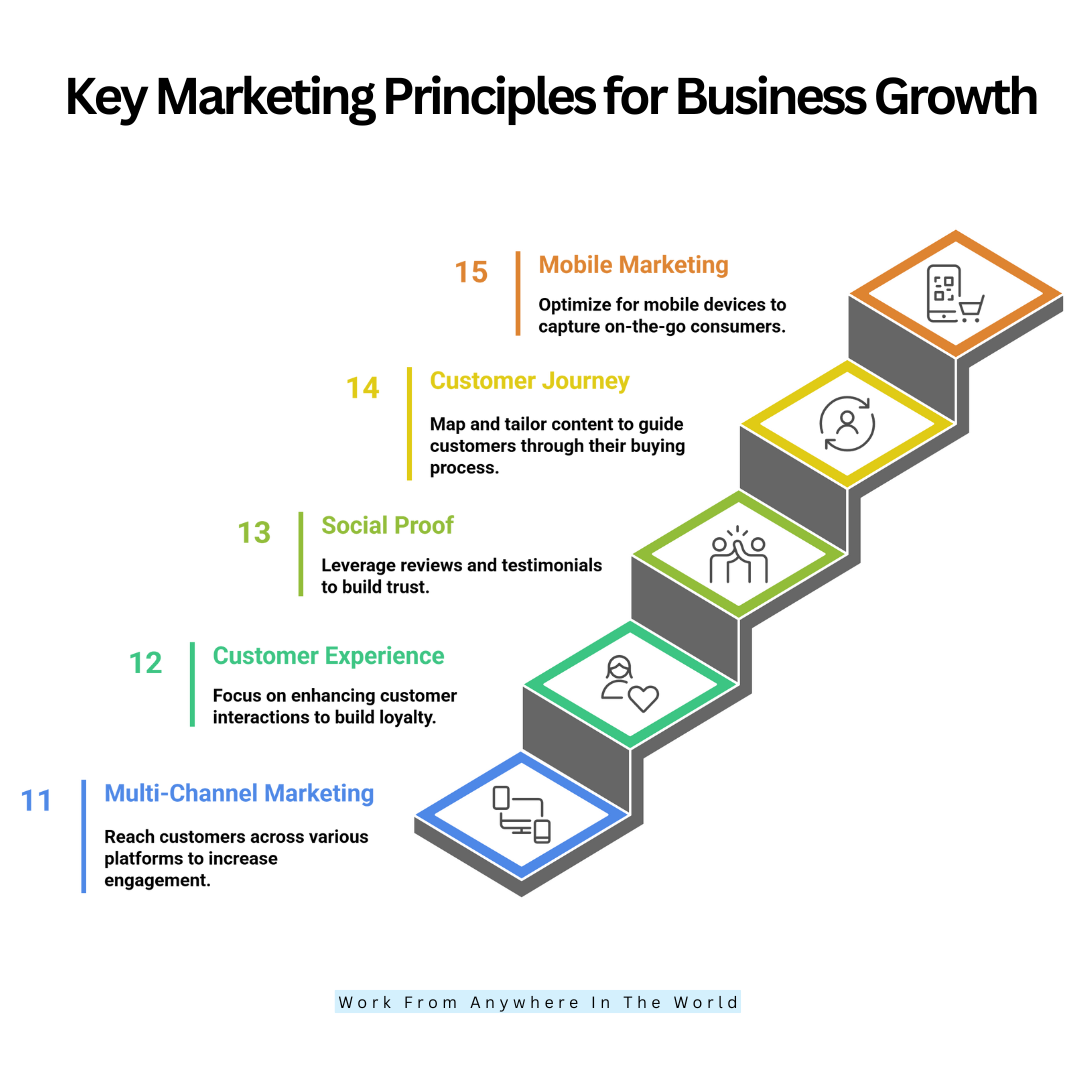
16. Use Personalization In Marketing
Personalization transforms generic marketing into meaningful interactions. Eighty percent of consumers are more likely to purchase from companies that provide individualized experiences, according to Epsilon.
Netflix, for instance, suggests shows based on viewing history, increasing engagement. Implement personalization by using customer data — like purchase history or browsing behaviour— to tailor emails, recommendations, and offers.
Tools like AI-driven CRMs or email marketing platforms make this easier. The process involves segmenting your audience, customizing messaging, and analyzing response rates.
Personalization builds stronger connections, improves customer satisfaction, and boosts conversion rates by making your audience feel valued and understood.
17. Apply A/B Testing Regularly
Regular A/B testing is one of the key marketing principles that empowers data-driven decisions and optimizes campaign effectiveness for better audience engagement.
For example, testing two subject lines in an email campaign can reveal which one gets more opens. Brands like Airbnb constantly use A/B testing to optimize user experience and campaign performance.
The process is simple: create two versions, run them simultaneously, and analyze the results based on predefined metrics like clicks or conversions. Data-backed judgments are made possible by A/B testing, which helps eliminate guesswork.
Your marketing efforts become more creative and successful when you conduct regular testing, which also enhances ROI and enables you to discover what appeals to your target demographic.
18. Invest In Video Marketing
Video content captures attention and drives engagement like no other medium. According to HubSpot, 86% of marketers say video increases lead generation.
Brands like Dollar Shave Club skyrocketed using viral video ads. Use videos for product demos, customer testimonials, behind-the-scenes content, and storytelling.
Platforms like YouTube, Instagram Reels, and TikTok offer massive reach. The process involves planning content, scripting, shooting, editing, and optimizing for SEO with relevant keywords and captions.
Video marketing boosts visibility, improves engagement, and delivers messages more effectively. In today’s fast-paced digital world, videos help you connect emotionally and informatively with your audience.
Wealthy Affiliate – Mini Review (2025)
If you’ve ever thought about turning your blog, passion, or niche into an online business,
Wealthy Affiliate (WA) is one of the most beginner-friendly platforms I’ve used.
It combines step-by-step training, website hosting, SEO research tools,
and an active community all in one place.
What I like most: you can start free (no credit card needed),
explore lessons, test the tools, and connect with other entrepreneurs
before upgrading. WA isn’t a “get rich quick” scheme — it’s a platform where success comes
from consistent effort and applying what you learn.
19. Implement Referral Marketing
Referral marketing harnesses the power of word-of-mouth by encouraging customers to promote your brand. Dropbox grew massively by offering extra storage for referrals.
It works because people trust recommendations from friends and family more than ads. Set up a referral program with clear incentives — discounts, freebies, or exclusive offers.
Promote it through email campaigns, social media, and your website. The process involves defining the reward structure, tracking referrals, and recognizing top referrers.
Referral marketing builds credibility, expands your customer base, and drives organic growth. It turns satisfied customers into brand ambassadors, amplifying your reach without significant ad spend.
20. Commit To Continuous Learning And Innovation
Embracing continuous learning and innovation is one of the key marketing principles that keeps your strategies relevant, agile, and ahead of the competition.
Think about how brands like Spotify continuously innovate to stay relevant in a changing landscape. Follow industry news, attend webinars, and participate in workshops to keep your knowledge fresh.
Encourage your team to experiment with new platforms, tools, and strategies. The process involves setting aside time for learning, testing innovative ideas, and analyzing results. Innovation doesn’t always mean big changes — minor tweaks can lead to significant improvements.
By cultivating an attitude of constant learning, you make sure that your marketing tactics remain competitive, successful, and in line with the most recent market trends.
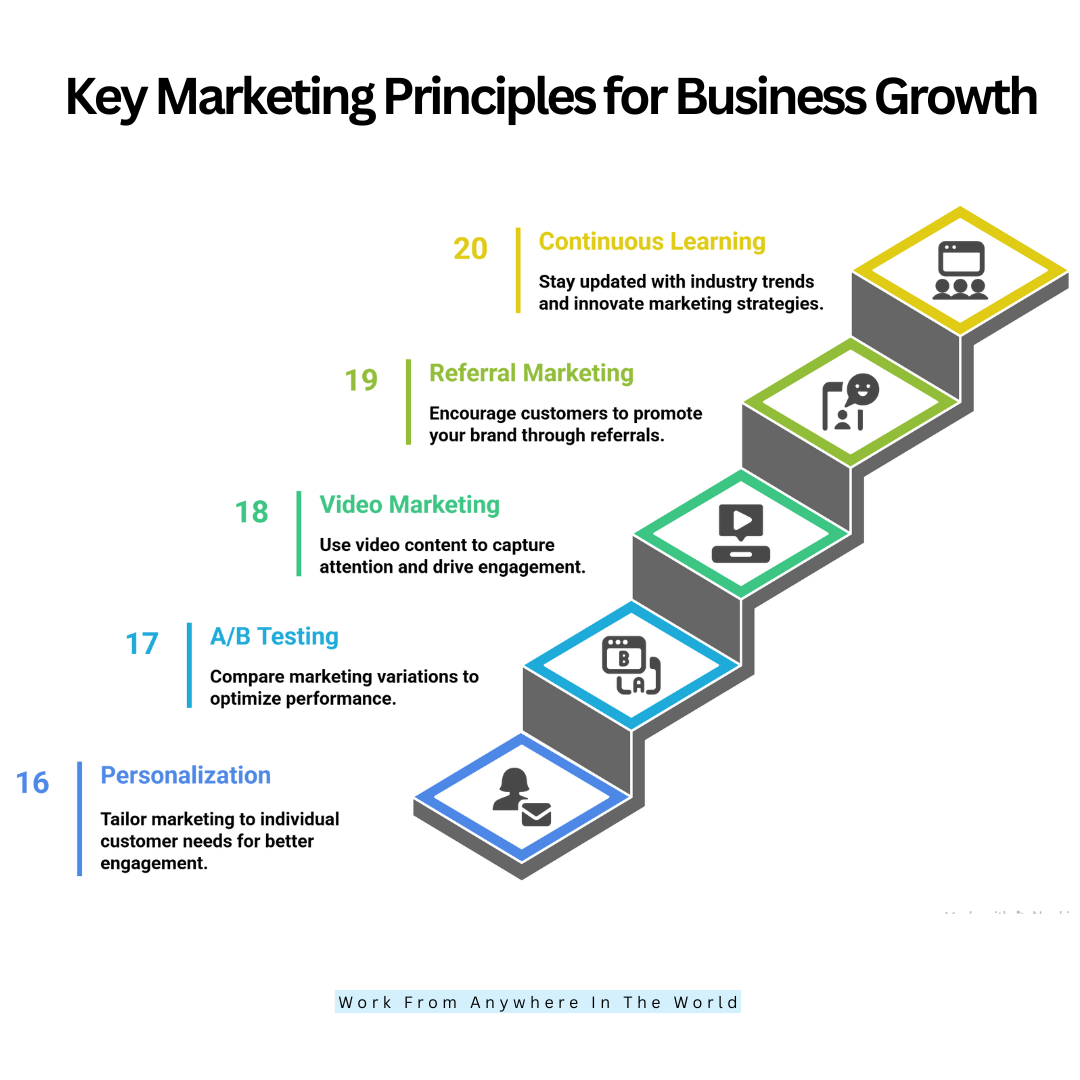
FAQs
1. What Are The Most Essential Marketing Principles For Beginners?
Learners should concentrate on developing original content, comprehending their target audience, being proficient in the Four Ps (Product, Price, Place, and Promotion), and developing a distinctive value proposition. These fundamentals lay the foundation for effective marketing strategies.
2. How Does Understanding The Target Audience Improve Marketing Success?
Knowing your audience helps you tailor your message, product, and channels to meet their specific needs, increasing engagement and conversion rates. It ensures your marketing efforts aren’t wasted on uninterested groups.
3. Why Is A Unique Value Proposition (UVP) Essential?
A UVP communicates why your brand is different and better, helping you stand out from competitors. It attracts the right customers and guides your marketing messaging consistently.
4. How Can Data-Driven Marketing Improve My Campaigns?
Data helps you analyze what works and what doesn’t, enabling you to optimize campaigns for better results, reduce costs, and make informed decisions rather than relying on guesswork.
5. What Role Does Branding Play In Marketing?
Branding creates an emotional connection and trust with your customers. Strong brands are memorable and encourage loyalty, making marketing more effective over time.
6. Is Content Marketing Still Relevant?
Absolutely. Through education and trust-building, content marketing draws in leads naturally and nurtures them during the purchasing process. It’s a long-term investment in relationships.
7. How Can I Assess Whether My Marketing Initiatives Are Working?
Use key performance indicators (KPIs) like conversion rates, ROI, engagement metrics, and customer acquisition costs—tools such as CRM platforms and Google Analytics aid effective tracking of these.
Conclusion
Understanding and applying key marketing principles can set your business apart and fuel long-term success. By focusing on customer needs, delivering value, and staying adaptable, you’ll build stronger connections and drive growth.
Keep refining your strategies and remain committed to your goals. Marketing isn’t a one-time effort — it’s a continuous journey of learning and improving. Let these principles guide you as you move forward in building a thriving brand.
I trust you enjoyed this article on the Key Marketing Principles For Business Growth. Please stay tuned for more insightful blogs on affiliate marketing, online business, and working from anywhere in the world.
Take care!
— JeannetteZ
💬 Your Opinion Is Important To Me
Do you have thoughts, ideas, or questions? I’d love to hear from you. Please leave your comments below or email me directly at Jeannette@WorkFromAnywhereInTheWorld.com.
📚 More Work From Anywhere Reads
🚀 Ready to Build a Business You Can Run from Home
or from Anywhere in the World?
Imagine creating income on your terms — from home, a cozy café, or wherever life takes you.
With the right tools, training, and community support, it’s entirely possible.
Start your own online business for free — no credit card needed.
Disclosure
This post may contain affiliate links. As an Amazon Associate and participant in other affiliate programs, I earn from qualifying purchases at no extra cost to you. Please read my full affiliate disclosure.

